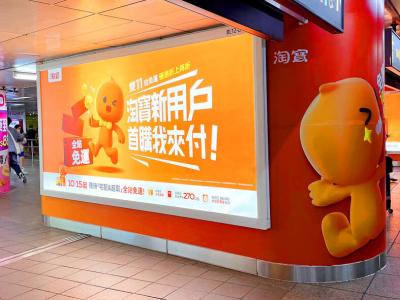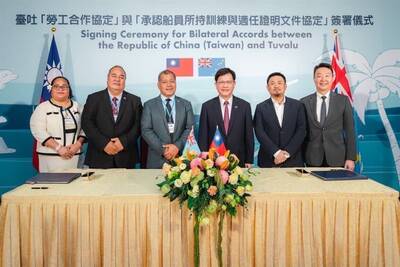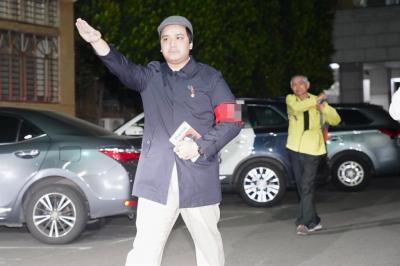As the amount of business waste is overtaking incinerator capacity, the Environmental Protection Administration (EPA) is promoting turning business refuse into solid recovered fuel (SRF).
Turning waste into energy can resolve waste disposal challenges and reduce fossil fuel use, EPA Deputy Minister Shen Chih-hsiu (沈志修) said on Friday.
Twenty-six percent of all waste incinerated last year came from commercial and industrial sources, Shen said, citing EPA data.
The power generation efficiency of incinerating regular waste is about 20 percent, but it can be increased to 30 percent via treatment, he added.
SRF is created from combustible components of waste, including plastics, biodegradable material, paper and metal.
It has a low environmental impact and low cost, and can be used as a substitute fuel in high-efficiency boilers and combustion facilities, emitting far less carbon than coal, Shen said.
Using SRF in industrial burners could lighten the load on incinerators, he added.
“At the moment, there is not enough capacity to handle household waste,” Shen said. “Hopefully, high-caloric refuse will not be incinerated, increasing capacity for household waste.”
About 2 million tonnes of business waste is incinerated every year, 700,000 tonnes of which can be turned into SRF, Department of Waste Management Director-General Lai Ying-ying (賴瑩瑩) said.
The EPA and the Ministry of Economic Affairs would work together to develop the field, Lai added.
Ling Yung-sheng (凌韻生), director of the Industrial Development Bureau’s Sustainable Development Division, said that the manufacturing sector produces more than 17 million tonnes of waste every year.
Through experimentation, testing and help from the EPA in establishing regulations, refuse can be transformed from a burden into an energy source, he said.
It could also form a new industrial supply chain, generating more economic benefits, he added.
“Waste is a misplaced resource,” Industrial Technology Research Institute green energy division deputy director Wan Hao-peng (萬皓鵬) said. “If it can be transformed into energy, new industrial applications could be developed.”
The institute has been researching SRF since 2001, Wan said, estimating that the nation is capable of transforming about 2.7 million tonnes of business waste into about 370 megawatts of energy, enough to power nearly 600,000 homes.
The paper, fabric and cement industries are contributing the most to SRF production, Shen said, expressing the hope that more industries would join in.
The EPA estimated that next year, 390,000 tonnes of waste would be transformed into fuel, increasing to 470,000 tonnes by 2023.

The Ministry of Economic Affairs has fined Taobao NT$1.2 million (US$36,912) for advertisements that exceed its approved business scope, requiring the Chinese e-commerce platform to make corrections in the first half of this year or its license may be revoked. Lawmakers have called for stricter enforcement of Chinese e-commerce platforms and measures to prevent China from laundering its goods through Taiwan in response to US President Donald Trump’s heavy tariffs on China. The Legislative Yuan’s Finance Committee met today to discuss policies to prevent China from dumping goods in Taiwan, inviting government agencies to report. Democratic Progressive Party Legislator Kuo Kuo-wen (郭國文) said

The Ministry of Economic Affairs has fined Taobao NT$1.2 million (US$36,900) for advertisements that exceeded its approved business scope and ordered the Chinese e-commerce platform to make corrections in the first half of this year or its license would be revoked. Lawmakers have called for stricter supervision of Chinese e-commerce platforms and more stringent measures to prevent China from laundering its goods through Taiwan as US President Donald Trump’s administration cracks down on origin laundering. The legislature’s Finance Committee yesterday met to discuss policies to prevent China from dumping goods in Taiwan, inviting government agencies to report on the matter. Democratic Progressive Party

Taiwan and its Pacific ally Tuvalu on Tuesday signed two accords aimed at facilitating bilateral cooperation on labor affairs, according to Taiwan’s Ministry of Foreign Affairs (MOFA). The governments inked two agreements in Taipei, witnessed by Foreign Minister Lin Chia-lung (林佳龍) and visiting Deputy Tuvaluan Prime Minister Panapasi Nelesone, MOFA said in a news release. According to MOFA, the agreements will facilitate cooperation on labor issues and allow the two sides to mutually recognize seafarers’ certificates and related training. Taiwan would also continue to collaborate with Tuvalu across various fields to promote economic prosperity as well as the well-being of their

Sung Chien-liang (宋建樑), who led efforts to recall Democratic Progressive Party (DPP) Legislator Lee Kun-cheng (李坤城), was released on bail of NT$80,000 today amid outcry over his decision to wear a Nazi armband to questioning the night before. Sung arrived at the New Taipei District Prosecutors’ Office for questioning in a recall petition forgery case last night wearing a red armband bearing a swastika, carrying a copy of Adolf Hitler’s Mein Kampf and giving a Nazi salute. Sung left the building at 1:15am without the armband and covering the book with his coat. Lee said today that this is a serious